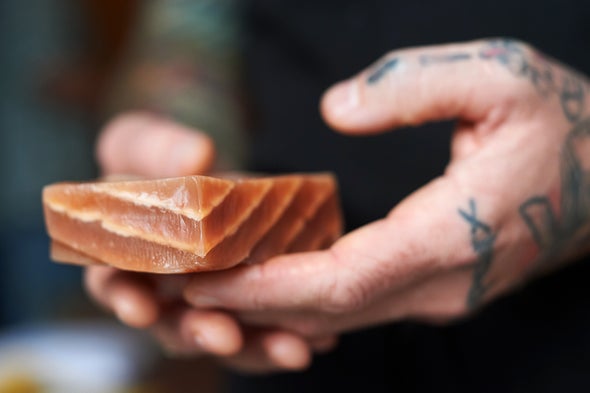Futuristic food science technology could finally bring plant-based salmon filets and tuna steaks to the table
Thank you for reading this post, don't forget to subscribe!
Like the Star Trek “replicator,” extruders can squirt out an astronomical range of prepackaged edibles—everything from Cheerios to cheese puffs to chewing gum relies on this process. The catch is that such products all have a similar texture, and they can’t be extruded raw. The process generates so much heat that it denatures, or unravels, most of the available protein molecules in the extruded material, rendering it somewhat shapeless. This is perfectly fine if people want to purchase a vegan crab cake. But it presents a challenge if they’re shopping for a raw fish substitute in order to re-create the experience of, say, biting into uncooked salmon crudo or searing a juicy tuna steak.
Luckily, food scientists are now finding creative new ways to re-create fish’s intricate sheets of parallel muscle fiber. One such technique is called directional freezing. This process capitalizes on the fact that ice tends to form in a certain direction—starting from the coldest point and moving outward. It also tends to adhere to itself, freezing in pure crystals of H2O. Some food researchers have applied directional freezing to blocks of gel made from edible algae. As the gel freezes, the water inside it solidifies into needlelike ice structures, creating a matrix of thousands of tiny tubes. This perforated gel makes a great scaffolding for uncooked faux fish.
That’s the strategy that New School Foods, a Canadian alternative meat start-up, is using to craft its plant-based raw salmon and tuna filets. “It’s basically like a directional sponge,” says Auke de Vries, New School Foods’ lead food materials scientist. Adjusting the size of the gel matrix or tweaking its freezing temperature can yield differently sized or shaped channels, “which is important because that’s the main driver of texture,” de Vries says.
Once the scaffolding is in place, the food science researchers can fill the channels by injecting them with whatever mixture of protein, fat and flavor they want. The options include 100 percent plant-based proteins, such as soy, pea or gluten, and—potentially—actual animal cells cultured in the lab. They can also add volatile flavor compounds that might otherwise break down in a precooked product. “We’re not married to any one ingredient,” says New School Foods founder Chris Bryson.
But there’s more than one way to skin a vegan catfish. Another method gaining traction in the alternative seafood world is 3-D printing. Revo Foods, a plant-based seafood manufacturer in Vienna, uses 3-D food printers to build smoked salmon filets from the ground up with carefully constructed layers of pea protein, algal extracts and omega-3 fatty acids.
If all of these techniques sound elaborate, it’s because they are. But the technology to make vegan meat and seafood is getting cheaper by the day, and its proponents believe the environmental benefits far outweigh the production hassle. “The impact that overfishing and harmful fishing practices have on vulnerable ocean ecosystems is very serious,” says Birgit Dekkers, a food scientist and co-founder of the Dutch plant-based meat company Rival Foods.
According to the Food and Agriculture Organization of the United Nations, overfishing and habitat destruction have depleted more than one third of global fish stocks. Not only does this wreak havoc on aquatic ecosystems, it can even contribute to global climate change by reducing the number of species available to store carbon. “The overall carbon footprint of ocean trawling is equivalent to the carbon footprint of the entire aviation industry,” Bryson says.
Persuading more people to switch to sustainable plant-based seafood isn’t going to fix climate change. But it could be a step toward ensuring that there are always plenty of fish in the sea.
ABOUT THE AUTHOR(S)
Joanna Thompson is an insect enthusiast and former Scientific American intern. She is based in New York City. Follow Thompson on Twitter @jojofoshosho0

